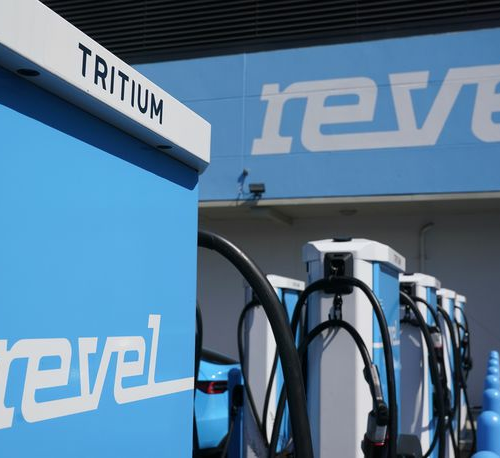BY JOHN VOELCKER | CarAndDriver.Com
Troy Warren for CNT #Cars
Here are the reasons that some of the quickest-accelerating cars on the planet are electric.
EVs are quick. Our testing has revealed that multiple mainstream EVs—including various sedans and SUVs that make no claim of being high-performance vehicles—can accelerate from zero to 60 mph in less than 5.0 seconds. Of 16 vehicles we’ve tested in the past decade that blasted to 60 mph in less than 3.0 seconds—supercar territory in the gasoline world—three of them were EVs.
Why are many of the latest EVs so quick? It’s down to the basic differences between electric motors and internal-combustion engines. When it comes to delivering their peak output, gasoline engines are surprisingly finicky things, and they tend to have far narrower horsepower and torque peaks than do electric motors.
To get a gas engine to deliver as much power to the drive wheels as possible, it needs the help of a transmission to match varying road speeds to the engine’s most powerful operating range. These days, high-volume passenger vehicles can have six to 10 gears in their transmissions. Even so, there’s lag off the line as the engine spools up from idle to, say, 2000 rpm or more, and that lag is a lot more noticeable with smaller turbocharged engines that increasingly populate today’s vehicles than it is with large naturally aspirated ones.
Big Torque Instantly
Suppose you had a vehicle with a powerplant that offered an almost flat torque curve, with close to maximum output at zero rpm—and no need for a transmission to optimize its acceleration from zero to 100 mph? That would solve most of the performance shortcomings associated with gas and diesel engines, wouldn’t it?
Such miraculous devices already exist: they are the motors that power electric cars. An electric motor that’s small in terms of its external dimensions compared to an internal-combustion engine (either gas or diesel) can nonetheless deliver remarkable torque. EVs also tend to get a packaging benefit—longer, more capacious cabins than gasoline cars of the same size and power—by separating their major propulsion components, such as having a motor at either axle and batteries tucked away under the cabin floor.
Electric motors’ inherent advantage in their ability to quickly deliver maximum torque from rest is the major reason so many EVs are quick. A secondary reason many mainstream EVs can leap away from stoplights as if being chased by a pack of coyotes is that they have front and rear motors working through all four tires. This extra traction enables them to channel more of their power to the pavement than if they had two-wheel drive and to launch from rest aggressively with minimum or no wheelspin. Many of the quickest gas-engine cars employ all-wheel drive for much the same reason.
Electric vehicles also tend to be spectacularly swift when punching it from cruising speed, a further advantage of electric motors’ quick responses and not having to wait for the multi-gear downshift that a gas-engine vehicle would do in that scenario. However, EVs’ lack of gearing does hurt their high-speed acceleration (say, 150 mph-plus) as well as their top speeds, which are generally much lower than their gas-engine supercar counterparts.
More Battery, More Power
Electric motors are simple, durable, and have far fewer moving parts than a combustion engine has, and the limit on their power often isn’t the motor itself but the EV’s battery. Keeping batteries healthy includes asking them to deliver power that’s proportional to their energy capacity, meaning the drivetrain can’t ask for all that energy at once.
For example, sometimes two models of the same EV are powered by the exact same motor, but the one paired with the larger battery pack is often rated for a significantly higher output. That’s because a larger pack tends to be able to flow power at a faster rate than a smaller one.
High Efficiency, Long Range, and Power
Electric cars use energy far more efficiently than do gasoline cars. Consider an EV with a 70.0-kWh battery—which can travel perhaps 250 miles, depending how fast you go. That 70.0 kWh is the amount of energy in roughly two gallons of gasoline—which would give you just 100 miles in an incredibly efficient 50-mpg car. To travel the same distance as the EV would take five gallons of gasoline, because about three-quarters of the liquid fuel is wasted as heat and noise, and only about 25 percent makes it to the wheels.
There’s also an unexpected relationship between fast EVs and their range. While powerful gas-engine vehicles have mediocre to lousy fuel economy—meaning they can’t go far unless they have a large gas tank—that tradeoff doesn’t exist in the same way with powerful, quick EVs. Although the efficiency ratings of extremely swift EVs certainly suffer—sometimes by as much as 25 percent—it takes a big battery to make big power in an EV, so some of the very quickest of the electric breed overcome their relative inefficiencies with more battery energy such that they still have some of the longest driving ranges.
The Gut vs. the Clock
Finally, it’s worth noting that EVs often feel quicker than they objectively are, precisely because their torque is delivered instantly. Tickle the accelerator or mash it; there’s no lag at all. You get as much power as you want sent to the vehicle’s tires almost instantaneously. The highest-performance EVs can harness this instant torque to accelerate fast enough to throw a cellphone sitting on the dashboard into the back seat. Mainstream EVs benefit in a similar, if lesser, fashion. Fine by us; we’ll never complain if a vehicle is quick—let alone if it feels even quicker and more lively than it actually is.


































